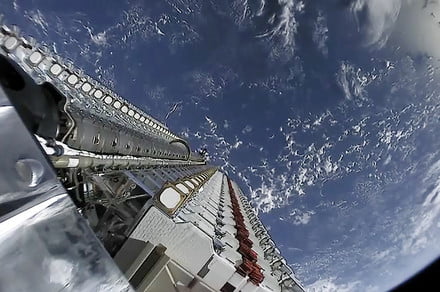SpaceX launched another batch of its Starlink internet satellites on Tuesday evening, marking the beginning of what’s expected to be a rapid uptick in such launches by the space exploration company.
In the company’s own words, the Starlink project aims to provide “fast, reliable internet to locations where access has been unreliable, expensive, or completely unavailable.” A number of other companies are competing with SpaceX to provide similar kinds of services.
This is the third batch of 60 satellites sent into low-Earth orbit by SpaceX as part of its plan to launch its first broadband services sometime this year. The first lot went up in May 2019.
The latest deployment saw a SpaceX Falcon 9 rocket launch from Space Launch Complex 40 at Cape Canaveral Air Force Station in Florida on Tuesday, September 7, with the entire event streamed live by SpaceX on its YouTube channel.
Successful deployment of 60 Starlink satellites confirmed! pic.twitter.com/hA8eUp7dNI
— SpaceX (@SpaceX) January 7, 2020
The mission marked the fourth outing for the Falcon 9’s first stage, which previously supported a Starlink mission in May 2019, the Iridium-8 mission in January 2019, and the Telstar 18 Vantage mission in September 2018.
As planned, following stage separation, the Falcon 9’s first stage returned to Earth, landing on the company’s drone ship positioned in the Atlantic Ocean. But SpaceX failed to catch part of the rocket fairing in a net on another ship when it came back down, indicating that there’s still work to be done to perfect this particular procedure.
SpaceX is planning to launch batches of 60 satellites every two to three weeks over the next 12 months, a rate that is expected to create enough coverage to provide global broadband by the middle of this year.
Astronomer concerns
One of the 60 satellites deployed on Tuesday has a special coating applied to one of its surfaces in a bid to make it less reflective when the sun’s rays hit it. The test comes in response to the concerns of astronomers who fear that the brightness of thousands of satellites will impact their ability to get a clear view of deep space, and also interfere with radio wavelengths used during the course of their space-related work.
If the measure proves effective, all future Starlink satellites would likely receive the same coating.
Gwynne Shotwell, SpaceX’s president and chief operating officer, said recently that the company is working with astronomers to find a solution and promised to “do trial and error to figure out the best way to get this done.”
Other companies such as Amazon and OneWeb are also aiming to provide high-speed broadband to unserved and underserved communities around the world by using internet satellites deployed in low-Earth orbit.
Just over half of the world’s population is currently able to access the internet, so blanketing areas with broadband from space offers huge revenue opportunities via various services for companies that succeed in setting up their space-based internet systems.

